by Susan Flantzer
© Unofficial Royalty 2019
The Basilica of Saint-Denis in the Paris suburb of Saint-Denis is the burial place of the Kings of France with nearly every king from the 10th to the 18th centuries being buried there, as well as many from previous centuries. The current Gothic cathedral was built in the 12th century. The basilica is named after Saint Denis, a patron saint of France, who became the first Bishop of Paris in the third century. He was decapitated on the hill of Montmartre and is said to have carried his head to the site of the current church, indicating where he wanted to be buried.
During the French Revolution, the remains of French royals were desecrated and some tombs and effigies were destroyed. The remains of 46 kings, 32 queens, and 63 other royals were thrown into two large pits in the monks’ cemetery adjacent to the Basilica of Saint-Denis and covered in quicklime and soil. A combination of 70 effigies and tombs were saved because of the efforts of archaeologist Alexandre Lenoir who claimed them as artworks for his Museum of French Monuments.
In 1817, King Louis XVIII ordered the mass graves adjacent to Saint-Denis to be opened but due to the damage from the quicklime, identification of the remains was impossible. The remains were collected into an ossuary, a site serving as the final resting place of human skeletal remains, in the crypt of the basilica. Many of the effigies and tombs that Alexandre Lenoir had restored and preserved were returned to the Basilica of Saint-Denis.
-
- Unofficial Royalty: Basilica of Saint-Denis in Saint-Denis France
- Official Website: Cathedral Basilica of Saint-Denis
- For a list of burials at the Basilica of Saint-Denis, see Wikipedia: Basilica of Saint-Denis Burials
- For a map of the tombs at the Basilica of Saint-Denis, see UK Tourism: Map of the tombs in the Basilica of Saint-Denis
********************
House of Valois (1328 – 1589)
The House of Valois, a cadet branch of the Capetian dynasty, succeeded the House of Capet in 1328. King Charles IV, the last king of the House of Capet died in 1328 without a male heir. The nearest male relative was his nephew King Edward III of England, son of his sister Isabella of France and her husband King Edward II of England. However, according to the Salic Law, King Edward III of England was ineligible to inherit the French throne through the female line. Philippe VI was Charles IV’s cousin in the male line and so he became King of France. Initially, King Edward III of England seemed to accept the Valois succession to the French crown but he pressed his claim to the throne of France after a series of disagreements with Philippe. The result was the Hundred Years’ War fought between France and England from 1337 to 1453.
- Philippe VI, reigned 1328-1350, son of Charles, Count of Valois, grandson of Philippe III
- Jehan II, reigned 1350-1364, son of Philippe VI
- Charles V, reigned 1364-1380, son of Jehan II
- Charles VI, reigned 1380-1422, son of Charles V
- Charles VII, reigned 1422-1461, son of Charles VI
- Louis XI, reigned 1461-1483, son of Charles VII
- Charles VIII, reigned 1483-1498, son of Louis XI
- Louis XII, reigned, 1498-1515, son of Charles, Duke of Orléans, great-grandson of Charles V
- François I, reigned 1515-1547, son of Charles, Count of Angoulême, great-great-grandson of Charles V
- Henri II, reigned 1547-1559, son of François I
- François II, reigned 1559-1560, son of Henri II
- Charles IX, reigned 1560-1574, son of Henri II
- Henri III, reigned 1574-1589, son of Henri II
*********************
All the monarchs listed below are interred at the Basilica of Saint-Denis with the exception of Louis XI. Any other burial places have Wikipedia links below. All portraits of Kings and Queens of France are from Wikipedia.
Philippe VI, King of France, reigned 1328 – 1350
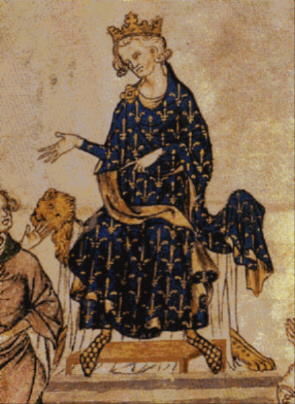
Born in 1293, Philippe VI was the eldest son of Charles, Count of Valois, the fourth son of King Philippe III of France, and his first wife Margaret, Countess of Anjou and Maine in her own right. Philippe VI initially had good relations with King Edward III of England who also had a claim to the French throne. A dispute over the Duchy of Aquitaine led to Edward III renewing his claim to the throne of France and started the Hundred Years’ War fought between France and England from 1337 to 1453.
Philippe married Jeanne of Burgundy. They had nine children but only three children survived childhood including Philippe’s successor King Jehan II of France. After Jeanne’s death, Philippe married Blanche of Navarre. Philippe and Blanche had one daughter.
Philippe VI, King of France died at the age of 57 on August 22, 1350, either at the Abbey Notre-Dame of Coulombs or the Château de Nogent-le-Roi, Eure-et-Loir, France both in the Loire Valley of France. He was buried at the Basilica of Saint-Denis.

Tomb of Philippe VI on the left and his son Jehan II on the right Credit – www.findagrave.com
Jeanne of Burgundy, Queen of France

Jeanne of Burgundy was the first wife of Philippe VI, King of France. Born on June 24, 1293, she was the fourth of the eight children of Robert II, Duke of Burgundy and Agnes of France, the youngest daughter of King Louis IX of France. Jeanne’s elder sister Margaret married King Louis X of France.
Jeanne died of the plague on December 12, 1349, at the age of 56. She was buried in the Basilica of Saint-Denis. Her tomb, built by her grandson Charles V, was destroyed during the French Revolution.
Blanche of Navarre, Queen of France

Born in 1330, Blanche of Navarre was the second wife of Philippe VI, King of France. She was the fourth of the nine children of Queen Jeanne II of Navarre, the only surviving child of Louis X of France, King of France and Navarre, and King Philippe II of Navarre.
Nineteen-year-old Blanche married 56-year-old Philippe VI shortly after his first wife died. Philippe died seven months after the marriage. Blanche was pregnant at the time of her husband’s death and gave birth to a posthumous daughter named Joan.
On 5 October 5, 1398, 68-year-old Blanche died at Neaufles-Saint-Martin in Normandy, France. She was buried in the Basilica of Saint-Denis next to her daughter who died in 1371.

Tomb of Blanche of Navarre, Queen of France on the right, next to the tomb of her daughter; Credit – www.findagrave.com
*********************
Jehan II, King of France, reigned 1350 – 1364
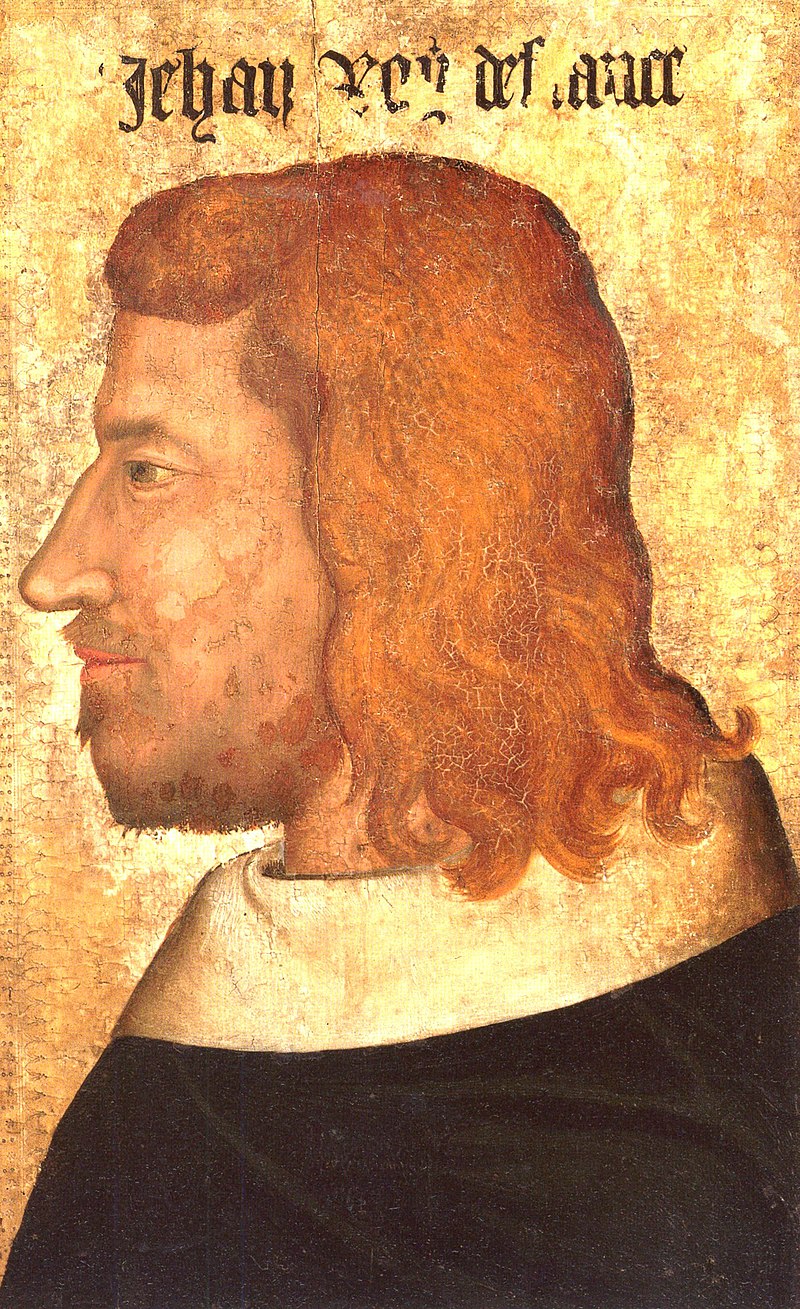
Jehan II was born on April 26, 1319, at the Château de Gué de Maulny in Le Mans, France. He was the eldest child of Philippe VI, King of France and his first wife Jeanne of Burgundy. In 1332, Jehan married Bonne of Luxembourg. The couple had ten children including Charles V, King of France, Jehan’s successor. Bonne died a year before Jehan became King of France. A year later, Jehan married Jeanne I of Auvergne, Countess of Auvergne and Boulogne. Jehan and Jeanne had three children who all died shortly after birth.
In 1356, Jehan was captured and taken prisoner by the English during the Battle of Poitiers, a battle of the Hundred Years’ War. Jehan’s eldest son Charles arranged for his father to be freed by ceding French territories to the English, paying a large ransom, and exchanging hostages which included Jean’s second son Louis, Duke of Anjou. When Jehan was informed that his son Louis had escaped from his captivity, he voluntarily returned to England, where he died at the age of 44 on April 8, 1364, at the Savoy Palace in London, England. Jehan’s remains were returned to France and he was buried in the Basilica of Saint-Denis.

Tombs of Jehan II on the right and his father Philippe VI on the left; Credit – www.findagrave.com
Bonne of Luxembourg, Duchess of Normandy

Bonne of Luxembourg was the first wife of Jean II, King of France. She died before her husband became King of France. The second of the seven children of King Johann of Bohemia and his first wife Elisabeth of Bohemia, Bonne was born on May 20, 1315, in Prague, Kingdom of Bohemia, now in the Czech Republic. She married Jean when he was 13-years-old and she was 17-years-old. Bonne gave birth to ten children in ten years. On September 11, 1349, Bonne died at the age of 34 from the plague at Maubisson Abbey in Saint-Ouen-l’Aumône, Val-d’Oise, France where she was also buried.
Jeanne I, Countess of Auvergne and Boulogne, Queen of France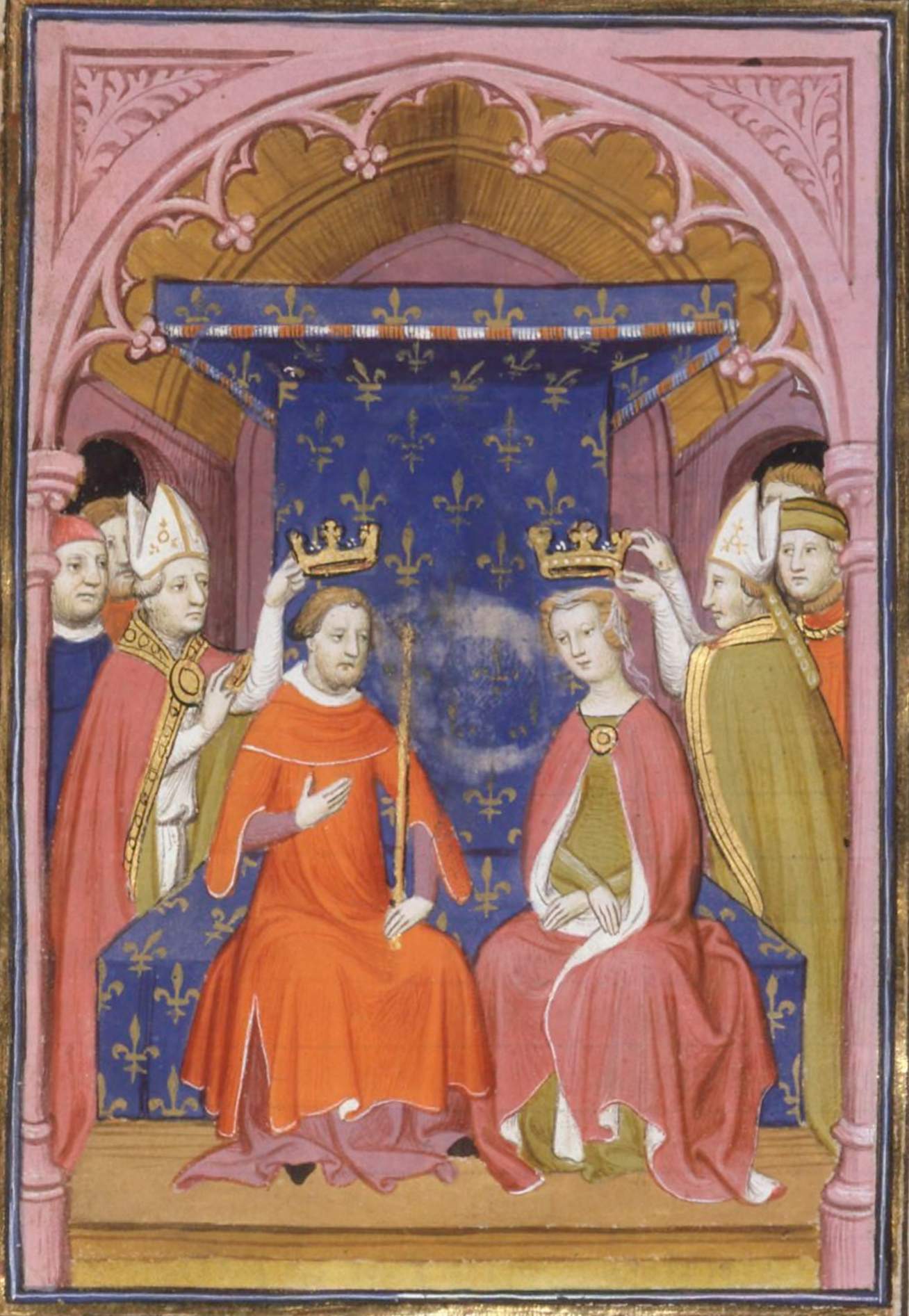
Born on May 8, 1326, Jeanne I, Countess of Auvergne and Boulogne (in her own right) was the only child of William XII, Count of Auvergne and Boulogne and Margaret of Navarre. Jeanne first married Philip of Burgundy in 1338 and they had three children. Jeanne’s first husband died in 1346 during a siege after falling from his horse. Following the death of her husband, Joan married Jean, then Duke of Normandy on February 13, 1350. Six months later, upon the death of his father Jeanne’s husband became Jean II, King of France. Jeanne gave birth to three children but they all died in infancy. On September 29, 1360, Jeanne died from the plague at the age of 34, just like Jean’s first wife, at the Château de Vadans in Franche-Comte, Burgundy. She was buried in the Basilica of Saint-Denis but her tomb has been lost.
*********************
Charles V, King of France, reigned 1364 – 1380

Charles V was the eldest of the ten children of Jean II, King of France and his first wife Bonne of Luxembourg. He was born on January 21, 1338, at the Château de Vincennes outside of Paris. His grandfather King Philippe VI gave him the province of Dauphiné to rule and the title Dauphin. This led to all future heirs apparent of France holding the title of Dauphin until their accession to the throne. In 1350, Charles married his cousin Jeanne of Bourbon and the couple had nine children including Charles’ successor Charles VI, King of France.
Charles always had poor health and probably suffered from tuberculosis. The death of his wife in childbirth in 1378 was devastating to him and affected his health. Charles V, King of France, aged 42, died on September 16, 1380, at Beauté-sur-Marne, France probably from the plague. Charles was buried near his wife at the Basilica of Saint-Denis while his viscera were interred next to his mother at Maubisson Abbey, and his heart was buried at Rouen Cathedral in Normandy, France.

Tombs of Charles V and his wife Jeanne of Bourbon; Credit – www.findagrave.com
Jeanne of Bourbon, Queen of France

Born at the same place and a few days after the birth of Charles V, her cousin and future husband, Jeanne of Bourbon was born on February 3, 1338, at the Château de Vincennes outside of Paris. She was the daughter of Peter I, Duke of Bourbon, and Isabella of Valois, a half-sister of Philippe VI of France. Charles V and Jeanne were both just twelve-year-old when they were married on April 8, 1350. They had nine children but only two survived childhood.
After giving birth to her last child, Jeanne died on February 6, 1378, three days after her 40th birthday, at the royal residence, Hôtel Saint-Pol in Paris. Jeanne was buried at the Basilica of Saint-Denis with her viscera buried at the Cordeliers Convent in Paris and her heart buried at the Convent of the Celestines in Paris.
*********************
Charles VI, King of France, reigned 1380 – 1422

Charles VI, King of France and his brother Louis, Duke of Orléans were the only two of the nine children of Charles V, King of France and Jeanne of Bourbon to survive childhood. Charles VI was born at the royal residence, Hôtel Saint-Pol in Paris on December 3, 1368. When his father died in 1380, the twelve-year-old succeeded to the French throne.
17-year-old Charles married 14-year-old Isabeau of Bavaria in 1385. They had twelve children and seven of them survived childhood. Their notable children were Charles VI’s successor Charles VII who was a supporter of Joan of Arc, Isabella of Valois, the second wife of King Richard II of England, and Catherine of Valois, the wife of King Henry V of England and Owen Tudor. Catherine of Valois and Owen Tudor were the great-grandparents of King Henry VII of England, the founder of the House of Tudor.
Charles VI like his grandson King Henry VI of England suffered from mental illness. It is probable that Charles was schizophrenic. He had many psychotic episodes and perhaps the most memorable one was his fear that he was made of glass and might shatter into pieces. After a 42-year-reign, Charles VI, King of France died at the age of 53 on October 21, 1422, at the Hôtel Saint-Pol in Paris and was buried at the Basilica of Saint-Denis.

Tombs of Charles VI of France and his wife Isabeau of Bavaria; Credit – Wikipedia
Isabeau of Bavaria, Queen of France

Isabeau of Bavaria was most likely born around 1370 in Munich, then in the Duchy of Bavaria. She was the younger of the two surviving children of Stephen III, Duke of Bavaria and his first wife Taddea Visconti of Milan. When she was 14-years-old, Isabeau was sent to France on approval to the young French king, Charles VI. The couple was married three days after their first meeting.
Although Isabeau gave birth to twelve children, her husband’s mental illness plagued their marriage. Often Charles VI did not recognize Isabeau during his psychotic episodes and was upset by her presence so she distanced herself during those episodes. Isabeau died at the Hôtel Saint-Pol in Paris on September 24, 1435 at around the age of 65. She was buried at the Basilica of Saint-Denis.
*********************
Charles VII, King of France, reigned 1422 – 1461
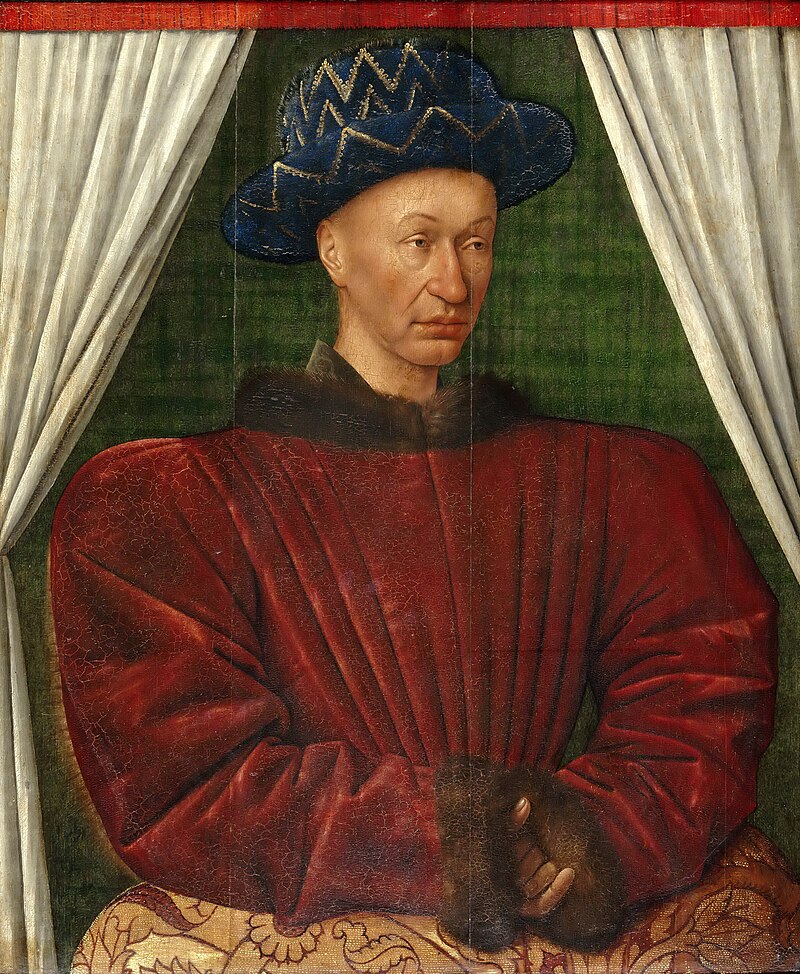
King Charles VII of France was born at the Hôtel Saint-Pol, the royal residence in Paris, on February 22, 1403. He was the eleventh child and fifth son of King Charles VI of France and Isabeau of Bavaria and outlived all four of his childless elder brothers.
In 1420, King Charles VI disinherited his only surviving son by signing the Treaty of Troyes whereby King Henry V of England, who had married Charles VI’s daughter Catherine of Valois, and his heirs would inherit the French crown upon the death of Charles VI. On October 21, 1422, the infant King Henry VI of England, the son of the recently deceased Henry V, also became titular King of France upon his grandfather Charles VI’s death in accordance with the Treaty of Troyes.
In 1422, Charles VII married his second cousin Marie of Anjou. Charles and Marie were both great-grandchildren of King Jean II of France and his first wife Bonne of Luxembourg. Fourteen children were born to Charles VII and Marie but only six survived childhood.
Still fighting the Hundred Years’ War, the forces of England occupied northern France in the 1420s. However, Charles’ political and military position improved dramatically with the emergence of Joan of Arc. Under the leadership of Joan of Arc, the English were defeated and Charles VII was able to be crowned King of France at Reims Cathedral, the traditional coronation site of the Kings of France. Charles VII appears as “The Dauphin” in plays and films about Joan of Arc.
In 1458, a sore on Charles’ leg became infected and never healed. He lingered on for the next three years becoming increasingly ill. On July 22, 1461, Charles VII, King of France died, aged 58, at Mehun-sur-Yèvre, France and was buried at the Basilica of Saint-Denis.
During the French Revolution, the tomb of Charles VII and his wife Marie was destroyed. The archaeologist Alexandre Lenoir was only able to save the heads of their effigies which he placed on display in his Museum of French Monuments. In the 19th century the, effigy heads were restored with new noses and new crowns and then sent to the National Archives and then to the Louvre. In the late 1990s, the effigy heads of Charles VII and Marie were returned to the Basilica of Saint-Denis and placed on columns facing each other, next to the tombs of Charles VII’s parents.

The effigy heads of Charles VII and his wife Marie of Anjou can be seen on either side toward the back of the photo; Credit – www.findagrave.com
Marie of Anjou, Queen of France

Marie of Anjou was born on October 14, 1404, in Angers, Duchy of Anjou, now in France. She was the daughter of Louis II, Duke of Anjou, a grandson of King Jean II of France, and Yolande of Aragon, daughter of King Juan I of Aragon. In 1422, Marie married King Charles VII of France. She gave birth to fourteen children including her husband’s successor King Louis XI of France.
Upon returning from a pilgrimage to Santiago de Compostela in Galicia in northwestern Spain, Marie fell ill. Marie of Anjou, aged 59, died on November 29, 1463, at the Cistercian Abbey of Notre-Dame des Châtelliers in Poitiers, France. She was buried next to her husband at the Basilica of Saint-Denis.

A sketch of the tomb of King Charles VII and his wife Marie of Anjou which was destroyed during the French Revolution; Credit – Wikipedia
*********************
Louis XI, King of France, reigned 1461 – 1483

The eldest child of the fourteen children of King Charles VII and France and Marie of Anjou, Louis XI was born on July 3, 1423, in Bourges, France. Because of the Hundred Years’ War with England, Louis grew up aware of the continuing weakness of France. He regarded his father as a weakling and despised him.
When Louis was 13-years-old, his father made a diplomatic marriage for him with Margaret of Scotland, the 11-year-old daughter of James I, King of Scots. The marriage was unhappy, and Margaret died childless at age 20, on August 16, 1445.
On February 14, 1451, 27-year-old Louis married nine-year-old Charlotte of Savoy without the permission of his father. Eventually, Charlotte gave birth to eight children but only three survived infancy including King Charles VIII of France and Jeanne of Valois who was briefly Queen of France as the first wife of King Louis XII.
Louis suffered several strokes with the first one occurring in 1473. It is likely that he died from a stroke on August 30, 1483, at the age of 60. Louis had given orders that he was not to be buried at the Basilica of Saint-Denis. Instead, he was buried at the Basilica of Notre-Dame de Cléry (in French) in Cléry-Saint-André, in north-central France, near Orleans.
Louis’ tomb has quite a history. His first tomb was an elaborate one. There was a bronze and gilded bronze statue of Louis praying on his knees in hunter’s clothes, holding a hunter’s hat with his dog. When Louis’ second wife Charlotte of Savoy died four months after her husband, she was buried with him. On April 2, 1562, Louis XI’s tomb was destroyed by French Huguenots.

The destruction of Louis XI’s tomb in 1562; Credit – Wikipedia
In 1622, King Louis XIII had a second marble tomb built by sculptor Michel Bourdin but it was destroyed during the French Revolution. However, archaeologist Alexandre Lenoir was able to preserve the statue of Louis XI and the four angels surrounding him which he displayed in his Museum of French Monuments. In 1896, a new canopy supported by four marble columns was made for statues of Louis and the angels which were then returned to the Basilica of Notre-Dame de Cléry.

1622 Tomb of Louis XI; Credit – Wikipedia
Margaret of Scotland, Dauphine of France

Margaret of Scotland was the eldest of the eight children of James I, King of Scots and Joan Beaufort, a great-granddaughter of King Edward III of England. She was only 11-years-old when she came to France to marry Louis, who was the Dauphin of France at the time.
Margaret was neglected by her husband and never had children. She developed a great interest in the French language and literature, became a patron of poets, and wrote poetry herself. Margaret was a favorite of her father-in-law Charles VII of France and popular with the courtiers. She had a strained relationship with her husband mainly because of Louis’ hatred of his father.
On August 16, 1445, Margaret, Dauphine of France died at the age of 20, at the Abbey of Saint-Etienne Châlons-en-Champagne in Châlons-sur-Marne, Marne, France probably from tuberculosis or pneumonia. She was first buried at the Cathedral of St. Etienne in Châlons-sur-Marne, France. In 1479, her remains were moved to the Collegiate Church of Saint-Laon (in French) in Thouars, France at the request of her husband King Louis XI.

Tomb of Margaret of Scotland, Dauphine of France at the Collegiate Church of Saint-Laon; Credit – Par Selbymay — Travail personnel, CC BY-SA 3.0, https://commons.wikimedia.org/w/index.php?curid=21619160
Charlotte of Savoy, Queen of France

The second wife of King Louis XI of France, Charlotte of Savoy was the ninth of the nineteen children of Ludovico I, Duke of Savoy and Anne of Cyprus. She was born in Chambéry, Duchy of Savoy, now in France, on November 16, 1441. The future King Louis XI of France, then the Dauphin of France, rebelled against his father and took refuge in his state of Dauphiné in southeastern France. He secretly negotiated with Ludovico I, Duke of Savoy to marry his daughter Charlotte. Louis was 27-years-old and Charlotte was only 9-years-old. The marriage was not consummated until Charlotte was 14-years-old.
Charlotte and her household were kept secluded at the Château of Amboise in the Loire Valley of France. She gave birth to eight children but only three survived childhood. Charlotte died on December 1, 1483, at the Château d’Amboise at the age of 42, just four months after the death of her husband. She was buried with him at the Notre-Dame de Cléry Basilica (in French).
*********************
Charles VIII, King of France, reigned 1483 – 1498
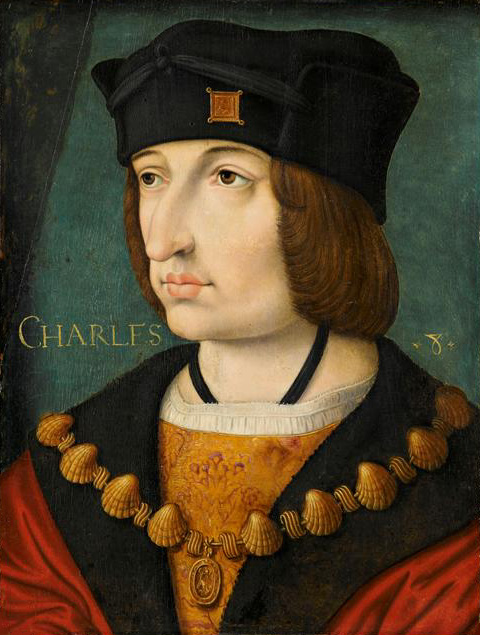
Charles VIII, King of France was the only surviving son of King Louis XI by his second wife Charlotte of Savoy. He was born on June 30, 1470, at the Château d’Amboise in the Loire Valley of France. Charles became King of France when he was 13-years-old and his elder sister Anne acted as his regent until 1491. That same year Charles married Anne, Duchess of Brittany in her own right. They had seven children but six of them were stillborn or died soon after birth. Their eldest child, a son, died from measles when he was three-years-old.
On March 20, 1498, Queen Anne gave birth to her last child, a daughter, who died on the day of her birth. To distract her from her sadness, on April 7, 1498, Charles decided to take Anne to watch a game of jeu de paume (real tennis). As they were walking to the tennis court at the Château d’Amboise, Charles violently hit his head on a stone lintel of a low door. He stumbled but did not lose consciousness and proceeded to the tennis court where he watched the game. At around two o’clock in the afternoon, Charles suddenly collapsed, fell into a coma, and died nine hours later at the age of 27.
Charles VIII, King of France was buried at the Basilica of Saint-Denis but his heart was buried at the Basilica of Notre-Dame de Cléry so he could be near his parents. His tomb at the Basilica of Saint-Denis was one of the most beautiful tombs there. It was made of gilded bronze and enamel and was quite large. The enameled statue of Charles VIII showed him praying, wearing a blue robe with fleur-de-lis (lily flowers). At the four corners were bronze angels and around the base were female figures in medallions. During the French Revolution, Charles’ tomb was destroyed and the materials melted down.
Charles’ widow Anne, Duchess of Brittany became the second wife of Louis XII, King of France, Charles’ successor. See her entry below under Louis XII.
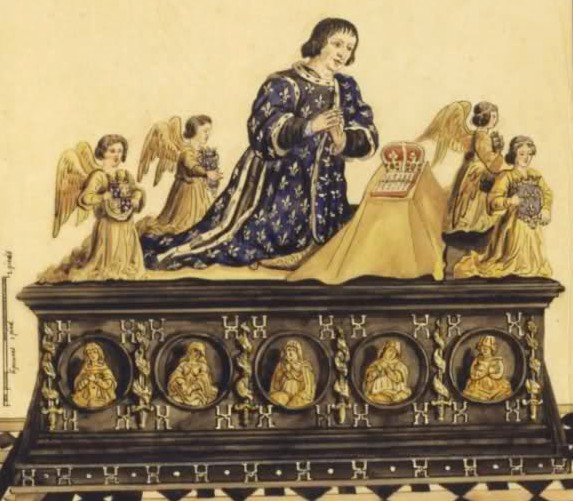
Tomb of Charles VIII; Credit – Wikipedia
*********************
Louis XII, King of France, reigned 1498-1515
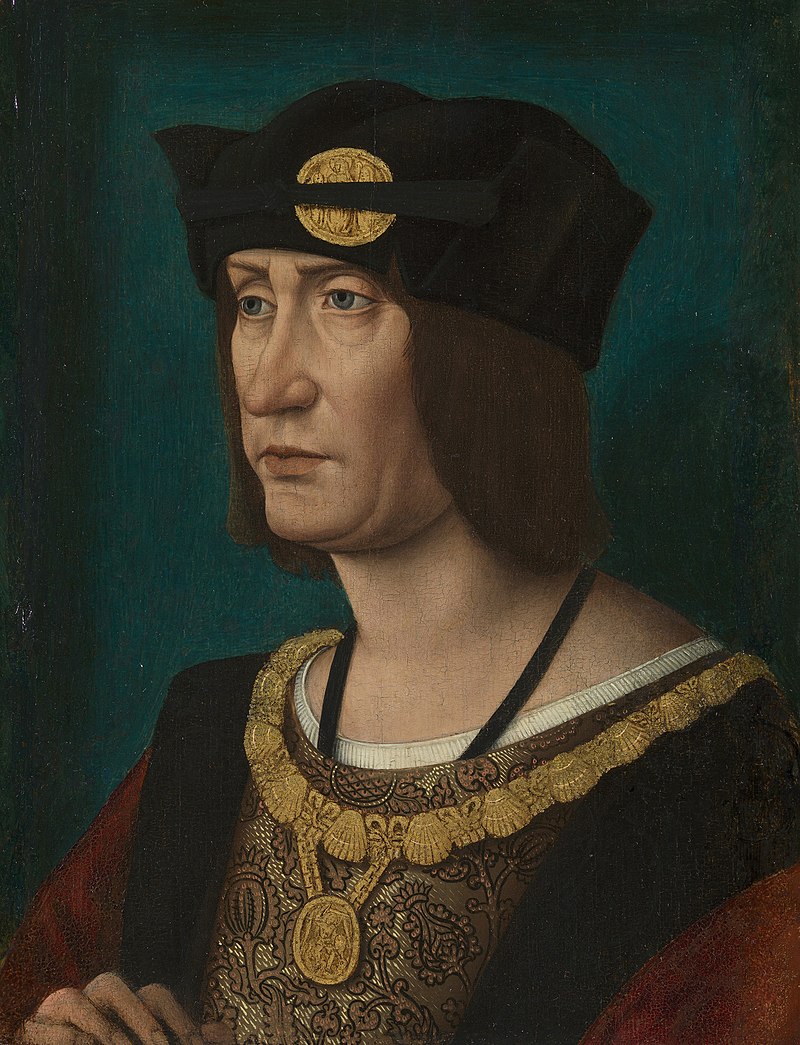
Louis XII, King of France was born on June 27, 1462, at the Chateau de Blois in Touraine, France, the only son and the second of the three children of Charles, Duke of Orléans and his third wife Marie of Cleves. Louis’ father Charles was the grandson of King Charles V of France through his second son, Louis, Duke of Orléans.
On September 8, 1476, 14-year-old Louis married 12-year-old Jeanne of Valois, daughter of King Louis XI of France. This was a political union arranged by King Louis XI, possibly to secure the succession due to the ill health of his heir, the future King Charles VIII of France. The marriage was unhappy, the couple lived apart, and there were no children.
King Charles VIII died unexpectedly in 1498. Although he and his wife Anne, Duchess of Brittany in her own right, had seven children, none had survived him, allowing Louis’ succession as King Louis XII of France. Charles VIII’s widow Anne returned to the Duchy of Brittany to regain the independence of the Duchy of Brittany from the Kingdom of France. Charles VIII’s successor King Louis XII had his marriage to Jeanne of Valois annulled so he could marry Anne of Brittany and gain her lands for France. Anne had several miscarriages and stillbirths but two daughters survived to adulthood. The eldest daughter Claude married François d’Angoulême, later King François I of France, and her father’s successor, and had seven children including King Henri II of France and Madeleine of Valois, first wife of James V, King of Scots.
Upon Anne of Brittany’s death in 1514, Louis was eager to provide himself a male heir and so the 52-year-old quickly arranged a third marriage to Mary Tudor, the eighteen-year-old daughter of King Henry VII of England and the younger sister of King Henry VIII of England. However, the marriage did not last long as Louis XII, King of France died on January 1, 1515, at the Hôtel des Tournelles in Paris, France, just three months after marrying Mary Tudor.
Louis XII was buried at the Basilica of Saint-Denis with his second wife Anne of Brittany and their tomb has survived although it was desecrated in October 1793 and their bodies were thrown into a mass grave. However, the archaeologist Alexandre Lenoir saved much of the tomb and preserved it at the Museum of French Monuments. During the Second Bourbon Restoration (1815 – 1830), the tomb was returned to the Basilica of Saint-Denis. Read more about it at Wikipedia: Tomb of Louis XII and Anne of Brittany.

Tomb of Louis XII and Anne of Brittany; Photo Credit – By Photo: Myrabella / Wikimedia Commons, CC BY-SA 3.0, https://commons.wikimedia.org/w/index.php?curid=18611160
Jeanne of France, Queen of France, Saint Joan of Valois (1st wife of Louis XII)

Jeanne of France, Queen of France, known in the Roman Catholic Church as Saint Joan of Valois, was the daughter of King Louis XI of France and his second wife Charlotte of Savoy. Jeanne was the first wife of Louis XII, King of France. The marriage was unhappy, the couple lived apart, and there were no children. Louis XII had his marriage to Jeanne of Valois annulled so he could marry Anne of Brittany, gain her lands for France, and hopefully have children. Jeanne of Valois founded the monastic Order of the Sisters of the Annunciation of Mary and was canonized as a saint in 1950. Jeanne, aged 40, died on February 4, 1505, at the convent she founded in Bourges, Duchy of Berry, now in France, and was buried in the chapel of the convent. On May 27, 1562, Jeanne’s tomb was desecrated and her remains were burned by the Huguenots during their sack of the city of Bourges

Chapel in the former Convent of the Order of the Annunciation of the Blessed Virgin Mary in Bourges, France that holds the empty sarcophagus of Saint Joan of Valois; Credit – http://www.anuncjatki.pl/eng/history.php
Anne, Duchess of Brittany, Queen of France, 2nd wife of Louis XII

Anne in prayer with St. Anne, St. Ursula and St. Helen
Anne was the elder of the two daughters of François II, Duke of Brittany and Margaret of Orléans. She was born on January 25/26, 1477 at the Château des ducs de Bretagne in Nantes, now in France. Anne became Duchess of Brittany in her own right at the age of 11 upon the death of her father and was considered quite a marriage catch because of her status as Duchess of Brittany. She was married by proxy in 1490 to the future Maximilian I, Holy Roman Emperor but the contract was dissolved by the Pope in 1492. By that time Anne had already been forced to repudiate her marriage contract to Maximilian and marry King Charles VIII of France. While married to Charles VIII, Anne had seven pregnancies but only one child survived infancy and he died when he was three-years-old.
When King Charles VIII died suddenly in 1498, Louis, Duke of Orléans from the Orléans branch of the House of Valois succeeded to the throne as King Louis XII. Louis was in a 24-year childless, unhappy marriage to Jeanne of France. Eager to get his hands on the Duchy of Brittany, Louis obtained an annulment and married Anne of Brittany. Anne had several miscarriages and stillbirths but two daughters by Louis XII survived to adulthood.
Exhausted by sixteen pregnancies in twenty years, 36-year-old Anne died after a kidney-stone attack at the Château de Blois in the Loire Valley on January 9, 1514. Anne was buried at the Basilica of Saint-Denis with her husband King Louis XII. (see photo above) Her heart was buried in her parents’ tomb at the Convent of the Carmelites in Nantes, Brittany, now in France.
Mary Tudor, Queen of France (third wife of Louis XII)

Mary Tudor was born on March 18, 1496, and was the daughter of King Henry VII of England and Elizabeth of York. Mary was betrothed to the future Charles V, Holy Roman Emperor, the eldest son of Philip the Handsome and Queen Joanna I of Castile. However, Mary’s brother King Henry VIII of England broke off Mary’s engagement to Charles and instead negotiated a peace treaty with France that included the marriage of 18-year-old Mary and the 52-year-old twice-married Louis XII who was eager to have a son to succeed him. Mary was not thrilled at the prospect of marrying a sick old man, especially since she was already in love with Charles Brandon, 1st Duke of Suffolk who had been brought up with Henry VIII in the court of King Henry VII. Apparently, Mary made her brother promise that if she should survive Louis XII, she could choose her second husband. Mary and Louis XII married on October 9, 1514, but the marriage did not last long as Louis XII died on January 1, 1515, just three months after the wedding.
Mary and Charles Brandon, 1st Duke of Suffolk did marry and had four children including Lady Frances Brandon, the mother of Lady Jane Grey. Mary’s health began to suffer around the time Henry VIII and Anne Boleyn married. There were rumors that the coronation of Anne Boleyn on June 1, 1533, broke Mary’s heart. Mary died on June 25, 1533, at the age of 37 and was originally buried in the Abbey at Bury St. Edmunds in England In 1538, when the Abbey at Bury St. Edmunds was dissolved during the Dissolution of the Monasteries, Mary’s coffin was brought to St. Mary’s Church in Bury St. Edmunds, England where it still rests in the crypt.

Original grave slab of Mary Tudor; Credit – www.britainexpress.com
*********************
François I, King of France, reigned 1515 – 1547

François I, King of France was the only son of Charles d’Orléans, Count of Angoulême and Louise of Savoy and a great-great-grandson of King Charles V of France through his father. He was born on September 12, 1494, at the Château de Cognac in Cognac, then in the Duchy of Aquitane, now in France. François became Count of Angoulême when he was two-years-old, upon the death of his father. When Charles VIII died childless in 1498 and was succeeded by Louis XII, who had no male heir, François became the heir presumptive to the throne of France.
In 1514, François married Claude of France, Duchess of Brittany in her own right, daughter of Louis XII, King of France and his second wife Anne, Duchess of Brittany. François and Claude had seven children including Henri II, King of France and Madeleine of Valois, first wife of James V, King of Scots. Claude died in 1524 and in 1530, François married Eleanor of Austria but the couple had no children.
On March 31, 1547, François I, King of France died at the age of 52 probably from kidney failure, although there were rumors of syphilis, at the Château de Rambouillet, southwest of Paris. He was buried at the Basilica of Saint-Denis with his first wife Claude of France. François and Claude’s tomb was desecrated during the French Revolution in October 1793. Archaeologist Alexandre Lenoir was able to save the tomb and preserved it at the Museum of French Monuments. It was returned to the Basilica of Saint-Denis during the Second Bourbon Restoration (1815 – 1830).

Tomb of Francois and Claude; Credit – Par Guilhem Vellut from Paris, France Tomb of François 1er @ Basilique de Saint-Denis @ Saint-Denis, CC BY 2.0, https://commons.wikimedia.org/w/index.php?curid=52701972
Claude of France, Duchess of Brittany, Queen of France (1st wife of François I)
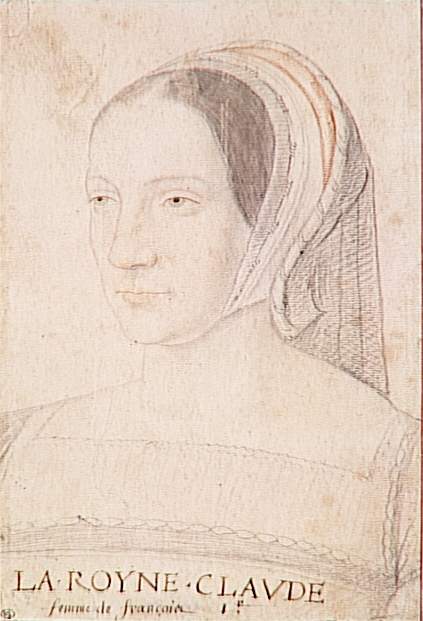
Claude of France was born on October 13, 1499, in Romorantin-Lanthenay in the Loire Valley of France. She was the daughter of Louis XII, King of France and his second wife Anne, Duchess of Brittany. Although Claude’s mother had seven pregnancies while married to Louis XII, Claude and her sister Renée were the only surviving children. Claude became Duchess of Brittany in her own right upon the death of her mother in 1514.
On May 18, 1514, Claude married François d’Orléans, Count of Angoulême, the heir presumptive to the French throne as Claude’s father had no sons. Less than a year later, Louis XII died and Claude’s husband succeeded to the French throne as François I, King of France. Early in her husband’s reign, Anne Boleyn, the future second wife of King Henry VIII of England, was a member of Claude’s household. Claude gave birth to seven children but only two lived past the age of eighteen.
Claude died on July 20, 1524, at the age of 24 at the Château de Blois in the Loire Valley. It is suspected that Claude had tuberculosis and contracted syphilis from her husband and certainly seven pregnancies in ten years weakened her health. Claude was buried at the Basilica of Saint-Denis and her husband was later buried with her.
Eleanor of Austria, Queen of France (2nd wife of François I)

Eleanor, Archduchess of Austria, Infanta of Castile was born on November 15, 1498, the daughter of Philip (the Handsome), Duke of Burgundy and Joanna, Queen of Castile and León and Queen of Aragon. On July 16, 1518, 19-year-old Eleanor became the third wife of 49-year-old Manuel I, King of Portugal. The couple had two children but the marriage lasted only three years as Manuel died from the plague in 1521.
To seal a treaty between Eleanor’s brother Charles V’s Holy Roman Empire and Habsburg Spain and François I’s Kingdom of France and his allies, François I, a widower for several years, agreed to marry Eleanor. They were married on July 4, 1530, but Eleanor was ignored by François who preferred his mistresses. Needless to say, Eleanor and François had no children.
After François’ death in 1547, Eleanor left France for the court in Brussels, then in the Spanish Netherlands, now in Belgium, where her sister Mary served as the Governor of the Spanish Netherlands. Physically exhausted after forty years of ruling, Eleanor’s brother Charles abdicated in 1555 and retired to the peace of the Monastery of San Jerónimo de Yuste in Cuacos de Yuste, Spain. In 1556, Eleanor and her sister Mary decided to follow their brother Charles into retirement in Spain. The three siblings all died in the same year: Eleanor on February 18, 1558, Charles on September 21, 1558, and Mary on October 18, 1558.
Eleanor was initially buried at the Cathedral of Saint Mary Major in Mérida, Spain. In 1574, on the order of her nephew King Philip II of Spain, Eleanor’s remains, along with the remains of other members of the Habsburg family, were transferred to a temporary crypt at the Royal Site of San Lorenzo de El Escorial in Spain which was under construction. In 1586, the remains were transferred to the permanent crypts at El Escorial, which is now the traditional burial site of the Spanish royal family. Eleanor’s remains rest in the Pantheon of the Infantes – Chapel 9 at El Escorial.

Tomb of Eleanor of Austria; Credit – Wikipedia
*********************
Henri II, King of France, reigned 1547 – 1559
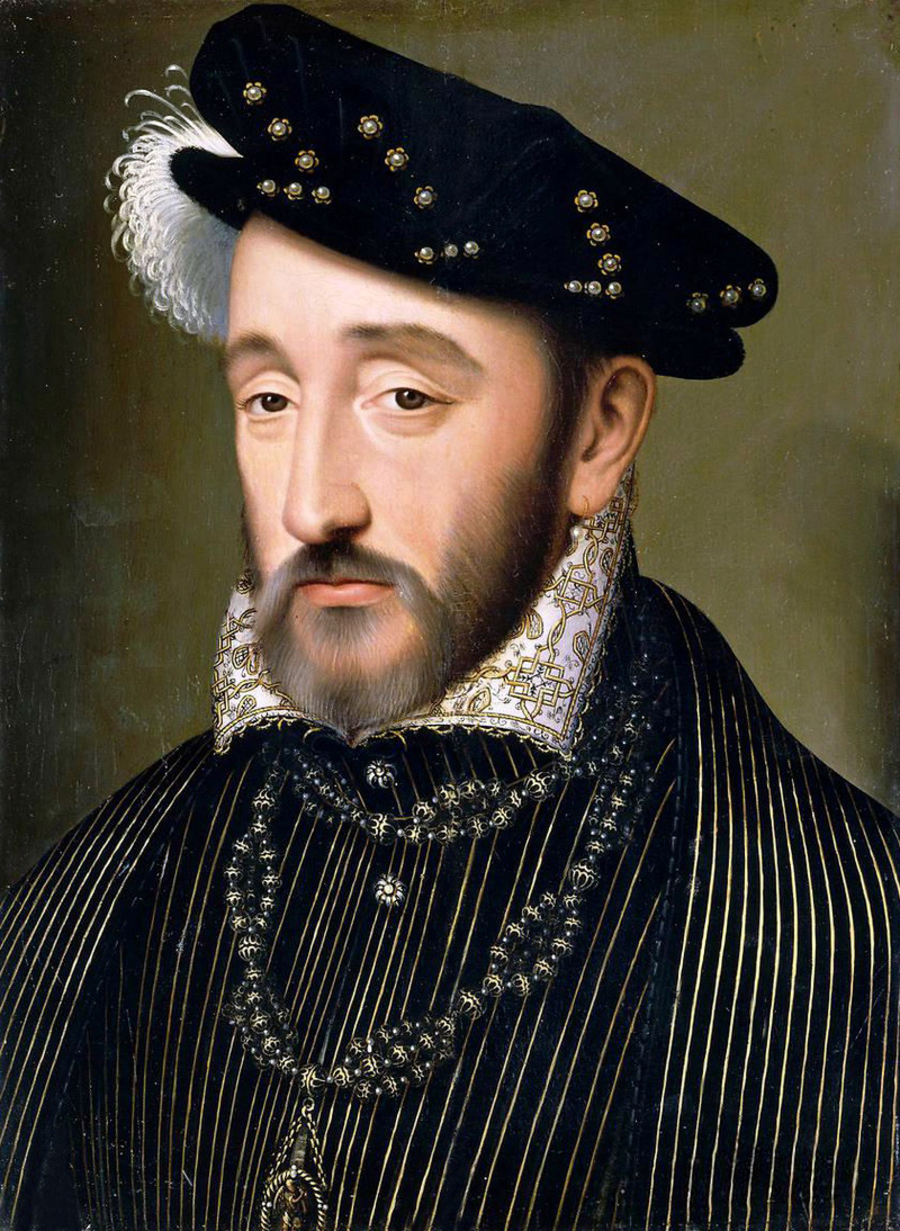
King Henri II of France was born on March 31, 1519, at the Château de Saint-Germain-en-Laye, near Paris. He was the second son of King François I of France and Claude, Duchess of Brittany, who was a daughter of King Louis XII and Anne, Duchess of Brittany. On October 28, 1533, Henri married Catherine de Medici, the daughter of Lorenzo II de Medici, Duke of Urbino and Madeleine de La Tour d’Auvergne. They had ten children with seven surviving to adulthood. Among their children were three Kings of France: François II, Charles IX, and Henri III; and two queen consorts: Elisabeth of Valois, Queen of Spain and Marguerite of Valois, Queen of France and Navarre.
In 1536, Henri’s elder brother François died at the age of 18. Henri became the heir to the throne and became king when his father died in 1547. Henri’s reign was marked by the Italian Wars against the House of Habsburg and the suppression of the Protestant Reformation, particularly the persecution of the Huguenots, who were becoming a large minority.
On June 30, 1559, Henri was severely injured while participating in a tournament. During a joust, his opponent’s lance struck Henri’s helmet, splintered, and went through the visor going through his right eye and through his temple into the brain. Henri was bleeding profusely and nearly unconscious. The splinter from the king’s eye was removed and he was bled as that was the medical practice at the time. It was hoped that the loss of the eye was the worst that would happen. As the days went by, Henri’s condition continued to worsen. On July 9, he was given the last rites and after eleven agonizing days, Henri II, King of France died on July 10, 1559, at the age of 40, probably from a subdural hematoma and sepsis.
Henri was buried at the Basilica of Saint-Denis and his heart and viscera were buried at the Convent of the Celestines in Paris. His wife Catherine de’Medici was later interred with Henri. Their tomb was desecrated during the French Revolution. Archaeologist Alexandre Lenoir was able to save the tomb and preserved it at the Museum of French Monuments. It was returned to the Basilica of Saint-Denis during the Second Bourbon Restoration (1815 – 1830).

Tomb of Henri II of France and Catherine de’Medici; Credit – Susan Flantzer
Catherine de’Medici, Queen of France
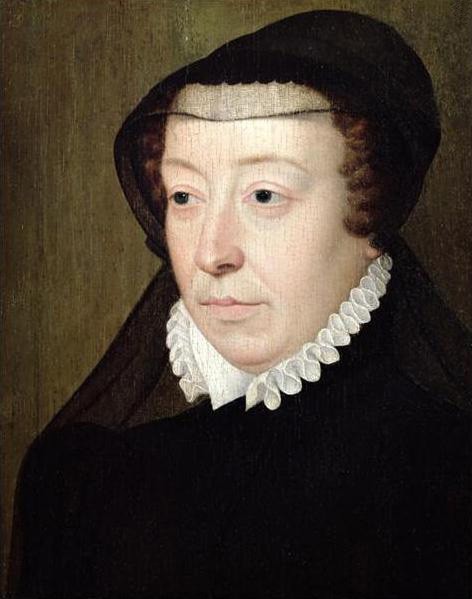
Catherine de’Medici was the only child of Lorenzo II de Medici, Duke of Urbino and Madeleine de La Tour d’Auvergne. She was born on April 13, 1519, in Florence, in the Republic of Florence, now in Italy. Catherine’s uncle Pope Clement VII arranged her 1533 marriage to the future Henri II, King of France. Henri paid little attention to his wife during the first ten years of their marriage, preferring mistresses. The couple did not have any children until they had been married for nearly eleven years.
After Henri’s death, Catherine had a role to play during the reigns of her three sons, all whom died without having sons. After only a 17-month reign, François II, King of France, aged 16, died and Catherine became regent for her 10-year-old son King Charles IX, and was granted sweeping powers. She played a role in plotting the St. Bartholomew’s Day Massacre of August 23-24, 1572 in which 5,000 to 30,000 Protestant Huguenots were killed. After Charles IX died in 1574, Catherine played a key role in the reign of her third son Henri III.
Catherine died of pleurisy at the age of sixty-nine on January 5, 1589, at the Château de Blois in the Loire Valley of France. Because the Basilica of Saint-Denis was held by the radical Catholic League which promoted the eradication of Protestants in Catholic France, Catherine could not be buried there. Instead, she was initially buried at Saint-Sauveur de Blois Church in Blois and then in 1610, her remains were transferred to the Basilica of Saint-Denis.
*********************
François II, King of France, reigned 1559 – 1560

François II, King of France was born on January 19, 1544, at the Château de Fontainebleau in France. He was the eldest of the ten children of Henri II, King of France and Catherine de’ Medici. François’ father Henri II, proposed to unite France and Scotland by marrying the young Queen of Scots to François, his three-year-old son and heir. Mary, Queen of Scots had become queen when she was six-days-old. In July 1548, the Scottish Parliament approved Mary’s marriage to François and the next month, five-year-old Mary, Queen of Scots set sail for France where she would be raised with her future husband.
On April 24, 1558, 15-year-old Mary married 14-year-old François outside Notre-Dame Cathedral in Paris. It was a marriage that could have given the future kings of France the throne of Scotland and also a claim to the throne of England through Mary’s great-grandfather, King Henry VII of England. A little more than a year after the wedding François’s father died from injuries sustained during a tournament and his eldest son succeeded his father as François II, King of France.
After only a 17-month reign, François II, aged 16, died in great pain on December 5, 1560, possibly from mastoiditis, meningitis, or otitis which turned into an abscess, at the Hôtel Groslot d’Orleans in Orléans, France. François’ remains were buried at the Basilica of Saint-Denis but his tomb has been lost. His heart was buried at the Convent of Celestines in Paris in a bronze urn atop a column. During the French Revolution, archaeologist Alexandre Lenoir was able to save the column that he preserved at the Museum of French Monuments. In 1817, it was moved to the Basilica of Saint-Denis.

The column that originally held the heart urn of François II; Credit – By Yair Haklai – Own work, CC BY-SA 4.0, https://commons.wikimedia.org/w/index.php?curid=80053463
Mary, Queen of Scots, Queen of France

Left a childless widow after the death of her husband François II, King of France, Mary, Queen of Scots decided to return to Scotland, where she married two more times, lost her throne, and was eventually beheaded after being held captive in England for eighteen years. Mary and her second husband and first cousin Henry Stuart, Lord Darnley, both grandchildren of Margaret Stuart, daughter of King Henry VII of England, had one child, who succeeded his mother as James VI, King of Scots after Mary was forced to abdicate, In 1603, James succeeded the childless Queen Elizabeth I of England as King James I of England.
After spending nineteen years of her life imprisoned in English castles, Mary was implicated in the Babington Plot, a plot to assassinate Queen Elizabeth I of England and was beheaded on February 8, 1587.
Mary had requested to be buried in France, but Elizabeth I denied the request. Her remains were embalmed, put in a lead coffin, and left in Fotheringhay Castle where she had been executed until August 1, 1587, when they were buried at Peterborough Cathedral in England where Catherine of Aragon, Henry VIII’s first wife had been buried. In 1612, Mary’s remains were exhumed upon the orders of her son, now King James I of England, and were reburied in a marble tomb with a beautiful effigy in Westminster Abbey in London, England in a chapel directly across the aisle from the chapel containing the tomb of Queen Elizabeth I.

Tomb of Mary, Queen of Scots in Westminster Abbey; Photo Credit – Wikipedia
*********************
Charles IX, King of France, reigned 1560 – 1574

Charles IX, King of France was the third but the second surviving son of Henri II, King of France and Catherine de’ Medici. He was born on June 27, 1550, at the Chateau de Saint-Germain-en-Laye near Paris. Upon the death of his elder brother François II, King of France, ten-year-old Charles became King of France. His reign was dominated by the French Wars of Religion. The St. Bartholomew’s Day Massacre, a slaughter of thousands of Protestant Huguenots, occurred during his reign.
On 26 November 1570, Charles married Elisabeth of Austria, daughter of Maximilian II, Holy Roman Emperor, and Maria of Spain, and they had one daughter who died when she was five-years-old. Charles’ health had always been problematic and in the aftermath of the St. Bartholomew’s Day Massacre and the religious wars, his condition weakened. Charles IX, King of France, aged 23, died from tuberculosis at the Château de Vincennes near Paris on May 30, 1574. He was buried at the Basilica of Saint-Denis but his tomb has not survived.

Funeral of Charles IX; Credit – Wikipedia
Elisabeth of Austria, Queen of France

Charles IX’s 20-year-old widow Elisabeth of Austria refused a second marriage and returned to her birthplace, Vienna, Austria. She founded the Convent of Poor Clares called Mary, Queen of Angels also known as the Queen’s Monastery, and retired there.
On January 22, 1592, Elisabeth died of pleurisy at the age of 37. She was buried under a simple marble slab in the choir of the church of the convent she founded. In 1782, the monastery was dissolved by Holy Emperor Joseph II under his reform policies and converted to the Lutheran City Church, the first Evangelical Lutheran church in Vienna. By order of Holy Roman Emperor Joseph II, Elisabeth’s remains were transferred to the Ducal Crypt at St. Stephen’s Cathedral in Vienna, Austria.
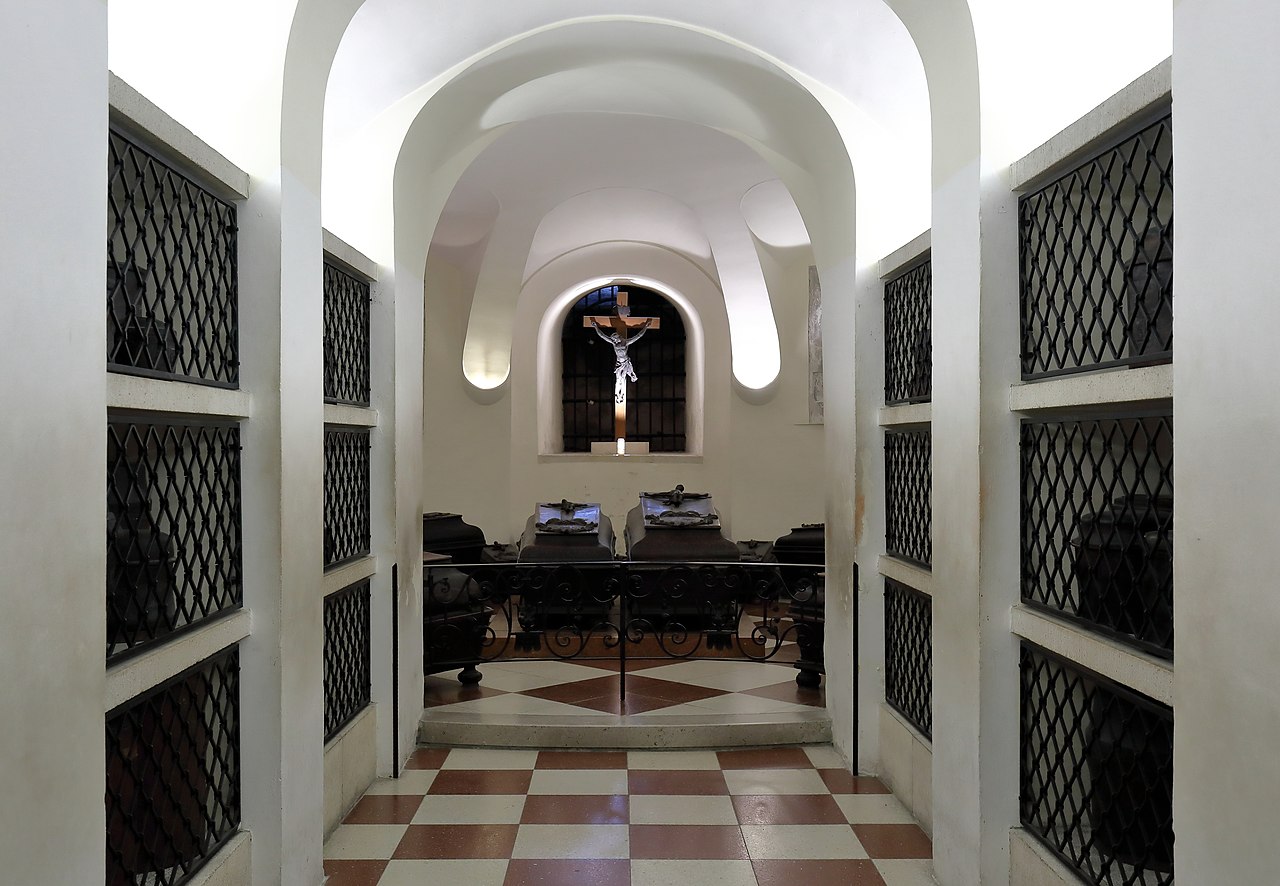
Ducal Crypt at at St. Stephen’s Cathedral, Elisabeth’s final resting place; Credit – By Bwag – Own work, CC BY-SA 4.0, https://commons.wikimedia.org/w/index.php?curid=66345452
*********************
Henri III, King of France, reigned 1574 – 1589

The last of the kings of the House of Valois, King Henri III of France was born at the Château de Fontainebleau in France on September 19, 1551. He was the fifth of the ten children and the fourth of the five sons of King Henri II of France and Catherine de’Medici. Even before he became king, Henri was a Catholic military leader in the French Wars of Religion – Catholics against the Protestant Huguenots – and helped plot the St. Bartholomew’s Day Massacre of August 23-24, 1572 in which 5,000 to 30,000 Protestant Huguenots were killed. The reigns of Henri and his two brothers who preceded him saw France in constant turmoil over religion.
In 1574, Henri’s brother King Charles IX died from tuberculosis and Henri succeeded as Henri III, King of France. In 1575, Henri married Louise of Lorraine, the only surviving child of Nicholas of Lorraine, Duke of Mercœur and Countess Marguerite d’Egmont. It was hoped that Henri and Louise would produce an heir to the throne but it was not to be.
After the death of Henri’s youngest brother and heir presumptive, the Protestant Huguenot King Henri III of Navarre was the rightful heir to the French throne. This led to what was known as the War of the Three Henris – King Henri III of Navarre, King Henri III of France, and Henri I, Duke of Guise. Henri I, Duke of Guise had formed the Catholic League which promoted the eradication of Protestants in Catholic France and removing Henri III from the French throne. In 1588, Henri III of France had Henri I, Duke of Guise assassinated by his bodyguard.
On August 1, 1589, 37-year-old Henri III was stabbed by Jacques Clément, a fanatic Dominican monk who sided with the Catholic League and believed Henri to be the enemy of Catholicism since the Duke of Guise’s assassination. After a day of agony, 37-year-old King Henri III of France died on August 2, 1589, at the Château de Saint-Cloud near Paris.
Henri III was buried at the Basilica of Saint-Denis but his tomb has not survived. His heart was placed in an urn atop a column at the Collegiate Church of Saint-Cloud. The column is now at the Basilica of Saint-Denis.

Henri III’s heart column and urn; Credit – www.findagrave.com
Louise of Lorraine, Queen of France

Louise of Lorraine was born in Nomeny in the Duchy of Bar, now in France, on April 30, 1553. She was the only surviving child of Nicolas of Lorraine, Duke of Mercœur and his first wife Countess Marguerite d’Egmont. Louise married Henri III, King of France on February 15, 1575, two days after his coronation. Henri and Louise never had any children.
After the assassination of Henri III in 1589, Louise became permanently depressed, always dressed in white, the traditional mourning color of French queens, and was nicknamed the “White Queen.” She lived in the Loire Valley of France at the Château de Chenonceau which she received as an inheritance from her mother-in-law Catherine de’Medici. The walls of her bed-chamber were all black and the décor were all symbols of mourning.
On January 29, 1601, Louise died at the age of 47. Her remains have rested in several places. The order of Capuchin Poor Clares was introduced in France by Louise. In her will, she left instructions and funds for her half-brother Philippe Emmanuel of Lorraine to build a convent in Bourges in the French Loire Valley that would be her burial site but he died soon after Louise. Eventually, a Capuchin Poor Clares convent was built with the funds but in Paris, instead of in Bourges and Louise’s remains were buried there in 1605. The Capuchin Poor Clares convent then occupied half of the current Place Vendôme. During the French Revolution, the nuns of the convent were driven out. In the early 1800s, the Rue de la Paix was constructed in the area of the convent, requiring its destruction. In 1806, Louise’s tomb was discovered during the destruction of the convent and her remains were buried at the Père-Lachaise Cemetery in Paris. On January 16, 1817, her remains were transferred to her final resting place, in the crypt at the Basilica of Saint-Denis, the traditional burial place of the French royal family.

Tomb of Louise of Lorraine, Queen of France; Credit – Wikipedia
*********************
This article is the intellectual property of Unofficial Royalty and is NOT TO BE COPIED, EDITED, OR POSTED IN ANY FORM ON ANOTHER WEBSITE under any circumstances. It is permissible to use a link that directs to Unofficial Royalty.

